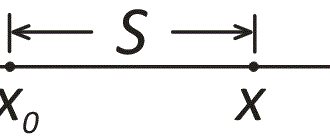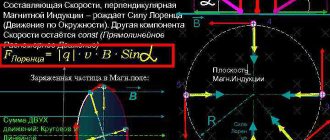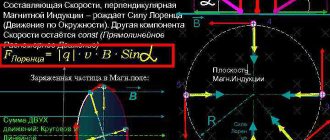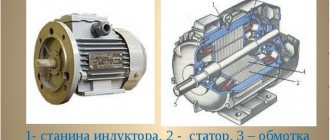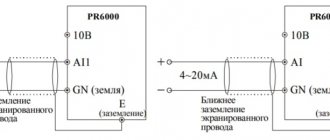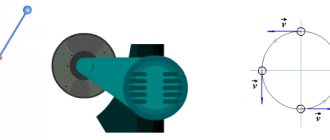Concepts and definitions Curvilinear movement is a movement whose trajectory is a curved line. The velocity vector of a body moving along a curved line is directed tangentially to the trajectory. Any section of curvilinear movement can be represented as movement along a circular arc or along a section of a broken line.
Circular motion with a constant absolute speed is a special and simplest case of curvilinear motion. This is motion with variable acceleration, which is called centripetal .
Features of motion in a circle with a constant absolute speed:
- The trajectory of a body is a circle.
- The velocity vector is always directed tangentially to the circle.
- The direction of speed is constantly changing under the influence of centripetal acceleration.
- Centripetal acceleration is directed towards the center of the circle and does not cause a change in the velocity module.
Linear speed
Each point on the circle moves at a certain speed. This speed is called linear. The direction of the linear velocity vector always coincides with the tangent to the circle.
For example, sparks from under a grinding machine move, repeating the direction of instantaneous speed.
Consider a point on a circle that makes one revolution, the time spent is the period T
. The path that a point travels is the circumference.
Formula for the time it takes for a point to rotate around a circle of a given radius
In order to calculate angular velocity, the following formula is used:
ω = ∆φ /∆t
Where:
- ω (read “omega”) is the actual calculated value.
- ∆φ (read “delta phi”) – rotation angle, the difference between the angular position of a point at the first and last moment of measurement.
- ∆t (read “delta te”) is the time during which this displacement occurred. More precisely, since “delta”, it means the difference between the time values at the moment when the measurement was started and when it was completed.
The above formula for angular velocity applies only in general cases. Where we are talking about uniformly rotating objects or the relationship between the movement of a point on the surface of a part, the radius and time of rotation, it is necessary to use other relationships and methods. In particular, a rotation frequency formula will be needed here.
Angular velocity is measured in a variety of units. In theory, rad/s (radians per second) or degrees per second are often used. However, this value means little in practice and can only be used in design work. In practice, it is measured more in revolutions per second (or minute, if we are talking about slow processes). In this regard, it is close to the rotational speed.
- Google+
- LJ
- Blogger
Centripetal acceleration
When moving in a circle, the acceleration vector is always perpendicular to the velocity vector, directed towards the center of the circle.
Using the previous formulas, we can derive the following relationships
Points lying on the same straight line emanating from the center of the circle (for example, these could be points that lie on the spokes of a wheel) will have the same angular velocities, period and frequency. That is, they will rotate the same way, but with different linear speeds. The further a point is from the center, the faster it will move.
The law of addition of speeds is also valid for rotational motion. If the motion of a body or frame of reference is not uniform, then the law applies to instantaneous velocities. For example, the speed of a person walking along the edge of a rotating carousel is equal to the vector sum of the linear speed of rotation of the edge of the carousel and the speed of the person.
Uniform rotation
If a body rotates through the same angle at equal intervals of time, then such rotation is called uniform. In this case, the angular velocity module is found as:
$$\omega=\frac{\varphi}{t}(2)$$
where $(\varphi)$ is the angle of rotation, t is the time during which this rotation is completed.
Uniform rotation is often characterized using the rotation period (T), which is the time it takes the body to complete one revolution ($\Delta \varphi=2 \pi$). Angular velocity is related to the period of revolution as:
$$\omega=\frac{2 \pi}{T}(3)$$
The angular velocity is related to the number of revolutions per unit time ($\nu) by the formula:
$$\omega=2 \pi \nu(4)$$
The concepts of the period of revolution and the number of revolutions per unit time are sometimes used to describe uneven rotation, but are understood as the instantaneous value T, the time during which the body would make one revolution if it rotated uniformly at a given instantaneous speed.
Connection to Newton's second law
According to Newton's second law, the cause of any acceleration is force. If a moving body experiences centripetal acceleration, then the nature of the forces that cause this acceleration may be different. For example, if a body moves in a circle on a rope tied to it, then the acting force is the elastic force.
If a body lying on a disk rotates with the disk around its axis, then such a force is the friction force. If the force stops its action, then the body will continue to move in a straight line
What is the angular velocity in specific cases?
Let's give an example of a calculation based on the above formulas. Let's say we have a car. When driving at 100 km/h, its wheel, as practice shows, makes an average of 600 revolutions per minute (f = 600 rpm). Let's calculate the angular velocity.
First, let's convert rpm to r/s. To do this, divide 600 by 60 (the number of seconds in a minute) and get 10 rps. Along the way, we also obtained the circulation period: this value is the inverse of the frequency and, when measured in seconds, 0.1 s.
Next we use the formula:
ω = 2 π *f
Since it is impossible to accurately express π in decimal fractions, the result will be approximately 62.83 rad/s.
- Google+
- LJ
- Blogger
Movement along a cycloid*
In the reference frame associated with the wheel, the point rotates uniformly along a circle of radius R with a speed that changes only in direction. The centripetal acceleration of a point is directed radially towards the center of the circle.
Now let's move to a stationary system connected to the ground. The total acceleration of point A will remain the same both in magnitude and direction, since when moving from one inertial reference system to another, the acceleration does not change. From the point of view of a stationary observer, the trajectory of point A is no longer a circle, but a more complex curve (cycloid), along which the point moves unevenly.
Instantaneous speed is determined by the formula
How to determine angular velocity: what is this quantity?
From a physical and mathematical point of view, this value can be defined as follows: these are data that show how quickly a certain point rotates around the center of the circle along which it moves.
WATCH THE VIDEO
This seemingly purely theoretical value has considerable practical significance when operating a car. Here are just a few examples:
- It is necessary to correctly correlate the movements with which the wheels rotate when turning. The angular speed of a car wheel moving along the inner part of the trajectory must be less than that of the outer one.
- You need to calculate how fast the crankshaft rotates in the car.
- Finally, the car itself, when going through a turn, also has a certain value of motion parameters - and in practice, the stability of the car on the highway and the likelihood of capsizing depend on them.
- Google+
- LJ
- Blogger
Moment of inertia I
In general, the value I introduced in the previous paragraph is calculated using the formula:
I = ∑i(mi*ri2).
Here i indicates the number of an element with mass mi, located from the axis of rotation at a distance ri. This expression allows you to perform calculations for a non-uniform body of arbitrary shape. For most ideal volumetric geometric figures, this calculation has already been made, and the resulting values of the moment of inertia are entered into the corresponding table. For example, for a homogeneous disk that makes circular motions around an axis perpendicular to its plane and passing through the center of mass, I = m*r2/2.
To understand the physical meaning of the moment of inertia of rotation I, one should answer the question about which axis is easier to spin the mop: the one that runs along the mop or the one that is perpendicular to it? In the second case, you will have to put in more effort, since the moment of inertia for this position of the mop is greater.
Which is better: power or torque?
Engine power and torque are interrelated quantities. This is clearly visible in the formula from the first paragraph.
The torque peak on the graph of the dependence of the engine speed appears earlier than the power peak. This is true for both diesel and gasoline engines. However, with diesel engines, torque is achieved earlier and the plateau (speed interval at peak value) is longer. Gasoline internal combustion engines have higher power, although to achieve it you need to spin the engine almost to maximum speed.
It is impossible to say definitely which is better: power or torque. It all depends on the case. The transmission of a modern car is capable of transforming these values under the required conditions. Let's explain with examples.
For heavy equipment that requires traction over a wide rpm range, torque is more important. The engine should pull well. There is no need to spin it to maximum speed. This is partly why almost all commercial vehicles are equipped with diesel engines.
Examples of problem solving
Problem 1. The centrifuge rotor makes 2•10 4 rpm. After the engine is turned off, its rotation stops after 8 minutes. Find the angular acceleration, as well as the number of revolutions that the rotor makes from the moment the engine is turned off until it stops completely, assuming that the rotor motion is uniformly accelerated.
Let's find the angular acceleration, taking into account that the angular velocity during uniformly accelerated motion is described by the equation: ω(t) = ω - εt.
From here, taking into account that at the end of the movement the speed is zero, we find: ε = ω/t = 2πn/t.
Translating these problems into the SI system of units (n = 333 rev/s; t = 480 s), we obtain: ε = 2π333/480 = 4.36(rad/s 2 ).
The rotation angle of the centrifuge rotor during time t will be: φ(t)= φ + ωt + εt 2 /2. Taking into account the expression for angular acceleration and the fact that φ = 0, we find: φ(t)= ωt/2 = πnt.
The number of rotor revolutions during this time will be: N = φ(t)/2π = πnt/2π = nt = 8•10 4 (rev.).
Answer: angular acceleration is 4.36 rad/s 2 ; the number of revolutions made by the rotor from the moment the engine is turned off until it stops completely is 8•10 4 rpm.
Problem 2. A disk with a mass of 1 kg and a radius of 20 cm rotates at a frequency of 120 rpm. in a minute. Under the action of the braking device, a friction force of 10 N began to act on the edge of the disk. Find the time the disk stopped after the friction force began to act on it.
Let's find the braking torque acting on the disk: M = RF.
Let's find the angular acceleration of the disk: ε = M/I = FR/mR 2 = F/mR.
Let's find the time it takes for the disk to stop: t = ω/ε, where ω is the initial angular velocity of the disk, which is equal to 2πv.
Let's do the calculations: t = 2πv/ ε = 2πvmR/F = 6.28•2•1•0.2/10 = 2.5 (s).
Answer: stopping time is 2.5 s.
The motion of a rigid body, in which all its points move along a circle, the centers of which are located on a fixed straight line perpendicular to these circles, is called rotational.
The fixed straight line on which the centers of the circular trajectories of the points of the body lie is called its
axis of rotation.
To form an axis of rotation, it is enough to fix any two points of the body. Examples of rotational motion of bodies include the movement of doors or window sashes when they are opened or closed.
Let's imagine a body in the form of a cylinder, axis AB
which lies in the bearings (Fig. 7.3).
Rice. 7.3. Towards the analysis of the rotational motion of a rigid body
It is impossible to unambiguously determine the rotational motion of a body by the movement of one point.
To establish the law of rotational motion of a body, by which it is possible to determine its position at a given moment, we draw through the axis of rotation of the body a fixed half-plane NP associated only with it, and inside the body we note a movable half-plane that rotates about the axis together with the body, now the angle φ formed by at any given moment in time by the half-planes NP and PP, accurately determines the position of the body in space (see Fig. 7.3). The angle φ is called the rotation angle
and is expressed in radians.
To determine the position of a body in space at any moment in time, it is necessary to know the relationship between the angle of rotation φ and time t
, i.e., to know the law of rotational motion of the body:
Acceleration, moment and their connection with mass
In addition to the above values, there are several other issues associated with rotation. Considering how many rotating parts of different weights there are in a car, their practical importance cannot be ignored.
Even rotation is important. But there is not a single part that rotates evenly all the time. The number of revolutions of any rotating component, from the crankshaft to the wheel, always eventually rises and then falls. And the value that shows how much the revolutions have increased is called angular acceleration. Since it is a derivative of angular velocity, it is measured in radians per second squared (like linear acceleration - in meters per second squared).
Another aspect is associated with movement and its change in time - angular momentum. If up to this point we could only consider purely mathematical features of movement, then here we need to take into account the fact that each part has a mass that is distributed around its axis. It is determined by the ratio of the initial position of the point, taking into account the direction of movement - and momentum, that is, the product of mass and speed. Knowing the moment of impulse arising during rotation, it is possible to determine what load will fall on each part when it interacts with another
- Google+
- LJ
- Blogger
